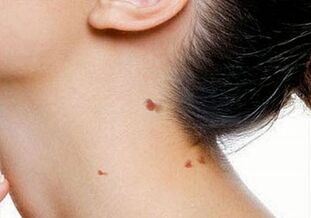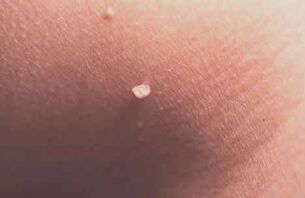
Cervical papilloma (fibrous warts) is the result of an infection of the human papillomavirus by ingestion or activation of the human papillomavirus (HPV) that is already present inside the cell. This location is often found on localization of tumors. Experts call it acrochord. They can appear not only on the neck, but also in the armpits, behind the ears, below the mammary glands.
Identifying the cause and choosing a treatment for papilloma of the neck is the task of specialists. Human papillomavirus infection is very dangerous to the health, can lead to the development of malignancies, especially in combination with genital warts and urogenital diseases.
The mechanism of the development of the disease
Papillomavirus is detected in the majority of sexual adults. The HPV virus enters the body through lesions, cracks, during massage, the use of hygiene products, the use of other people's shoes, and unprotected sex. For months or even years, the papillomavirus does not manifest itself in any way, indicating a chronic carrier. As the virus multiplies in the superficial layers of the skin, tissue hyperplasia occurs, and fibrous growth nodules appear on the neck and other parts of the body.
Important! HPV does not exist in the environment. Viruses quickly die on objects in the home. Infection occurs mainly through direct contact.
During shaving or manicures, you can infect yourself by activating an inactive virus. The disease progresses to an active clinical manifestation stage, and then hyperproduction processes appear on the skin.
The cause of a papilloma on the neck

It is almost impossible to say exactly why a papilloma appears on the neck. Experts identify the following trend factors:
- converts serious infectious diseases, surgical intervention that depresses the immune system, reduces the body's adaptive ability;
- frequently damages the skin with clothing, hygiene and care products;
- conducts massages that do not comply with infection-safe techniques, in low-quality beauty salons caused by workers infected with HPV;
- hormonal disorders, endocrine pathology;
- is present in other types of papillomas, genital warts, and warts on the body and genitals.
Experts think that the cause of the papilloma on the neck may be related to hormonal changes in the body. This confirms the fact that genital warts often appear after endocrine diseases, during pregnancy and during menopause, when sex hormone activity decreases.
In young women, papillomas on the neck are often caused by ovarian dysfunction. But initially HPV must be in an inactive form in the body. Hormonal spikes are just one stimulating factor.
Clinical manifestations
Cervical papilloma practically has no clinical manifestation. Outwardly, they look like sprouting filaments that are yellowish or flesh-colored. Tumors have a rather dense consistency. Their size rarely exceeds 6 mm. Usually, filamentous papillomas on the neck are found in small groups, which can grow together and form hive-like nests or cauliflower.
These papillomas are not susceptible to magnetization, but if they are damaged, the risk of tissue malignancy remains. Tumors may become inflamed, often provoking the spread of the papillomavirus to healthy skin with the emergence of new warts.
Examining for papillae on the neck
It is possible to determine the cause of papilloma on the neck and the treatment method during a comprehensive examination. If fibrous papules appear, you should consult a dermatologist.
Primary diagnostic methods for papillomas of the neck, armpits and other parts of the body:

- PCR; skin microscopy
- ;
- biopsy of cancerous tissues;
- histological examination.
Papillomas on the neck are distinguished from normal warts, fibroids, and birthmarks. Viruses can be identified during PCR research. This method allows you to determine the DNA of the virus, to assess the carcinogen level of the process of formation and the number of HPV. The two most dangerous types of HPV, 16 and 18, cause cervical cancer.
Papilloma biopsy is performed if a malignant process is suspected. Chronic papillomavirus infection contributes to tissue hyperplasia and often leads to magnets. Therefore, it is very important to promptly detect high-risk viruses and remove papillae.
Methods of treatment
The treatment for papillae on the neck has been selected individually. This takes into account:
- the number of students, their shape and their size;
- the patient's general health condition;
- extent of the risk of tumor malignancy;
- presence of concomitant diseases, including external and internal tumors, urogenital infections.
In order to understand how to get rid of papillae in the neck, the doctor ordered a complete examination, clearly identifying the type of HPV virus. Other tactics depend on this. Papillomas are the result of the active multiplication of the virus and the need for antiviral therapy.
Treatment with therapy
Medicines for human papillomavirus infections should be used only after consulting the attending physician. Such funds inhibit the further development of HPV, preventing complications, including malignancies.
Usually, experts prescribe a drug with antiviral activity, in addition to an immunomodulatory effect. It is extremely important, especially in frequent recurrences, to strengthen the immune system to reduce the number of exacerbations per year.
Treatment of human papillomavirus infection continues for several months. During the course of taking the drug, test parameters, blood and urine donation, should be monitored to promptly detect liver and kidney overload.
should be monitored to promptly detect liver and kidney overload.
If for some reason specialists postpone surgical treatment of the neck warts, then it is necessary to abandon clothing that is responsible for the tumor. With only small lesions, the risk of the papilloma virus spreading to healthy areas of the body increases dramatically.
In addition to antivirals, you can use ready-made medications to get rid of papillomas. But this treatment causes trauma. With the increased risk of causing cancer, it cannot be used.
Pharmaceutical products for papilloma removal
Prepared preparations for the removal of papillae on the neck contain acids and active ingredients that destroy cancer cells. You should use the money according to the instructions attached and after consulting your doctor.
Basic principles for removing warts and papillomas with ready-made products:
- Before using topical preparations, it is necessary to treat healthy skin with a zinc gel or vegetable oil;
- strictly prohibits the use of these products for the treatment of children under 10-12 years old and adults with sensitive skin and chronic allergic diseases;
- Do not apply medication to the mole.
If during the process of using drugs to remove papillae, part of the drug sticks to the skin or the healed mucosa, urgently wash the skin with running water and soap to neutralize acid and alkali.
Common medicines for getting rid of papillomas:
- Drug in the form of tablets, belongs to anti-inflammatory and immunomodulatory agents. Reducing the number of viruses, gradually reducing the size of the tumor. Recommendation should be combined with topical treatment.
- A preparation used to harden papillae to the root. During the use of the product, there is a slight stinging and burning sensation. The skin turns white and then reddens with the formation of blisters. Complete tissue regeneration takes place in 2-4 weeks.
- Application of the product is based on its cold effect on papilloma. Low temperature destroys tumors, severely disrupting the metabolism and nutrition of the tissues, leading to their death.
- Celandine products. Similar drugs are used to remove papillomas on the neck at home. In addition to the juice, they contain other active ingredients, including alkalis. Before using the product, healthy skin must be protected with a fatty cream, vegetable oil or zinc ointment.
Pharmaceutical products to combat papillomas are used according to official instructions for use. Certain drugs have active ingredients that can cause inflammation, irritation, and even chemical burns to tissues. With high sensitivity of the skin, such agents are contraindicated. It is better to use minimally invasive surgical methods to remove papillae on the neck.
Surgical treatment
Surgical treatment of papillomas is the gold standard. Any tumor that appears on the skin and mucous membranes against the background of a human papillomavirus infection must be eliminated. No therapist can guarantee that sooner or later a tumor will not lead to magnetization and development into a malignant tumor.
The main methods of surgical removal of papillomas on the neck:
- laser coagulation
- ;
- cryodestruction; Radio wave mode
- ;
- condenser capacitors;
- surgically removes the tumor with a scalpel.
The doctor chooses a specific method to remove papillae based on comprehensive examination data. Cut surgery is performed with a large tumor size and risk of malignancy. In other cases, therapists try to use minimally invasive techniques so as not to leave scars and pigmentation marks on the skin.
Laser coagulation

The laser effectively fights the growth of the skin and mucous membranes. This method delivers the most accurate and targeted effect on controlled tissue depths. There is no pain during surgery. Usually, specialists use either parenteral or applied anesthesia.
High energy lasers vaporize microscopic tumors with a highly targeted laser beam. In this case, there is a simultaneous coagulation of blood vessels. Exposure to high temperatures prevents the spread of papillomavirus from the bloodstream to healthy areas of the skin.
A scab forms where the papilloma is destroyed, which will go away on its own after about a week. Mild red skin persists for 2-3 months and then disappears completely.
Cryodestruction
Cryodestruction is based on the cold effect on skin tumors. Liquid nitrogen freezes the papillae and leads to their destruction. Then the tissues die off with the formation of a small crust.
During surgery, the cytoplasm and intercellular fluid are frozen, the cell structure of the papilloma is destroyed, making the tumor unable to live. Exposure to low temperatures stops lymphatic circulation and blood flow in the papilloma tumor tissues.
During the use of liquid nitrogen, the skin is whiter, slightly swollen, and after the procedure it turns red with the appearance of an invisible blister. Complete tissue regeneration takes several weeks.
Removing a papilloma with radio waves
Radio wave method for papilloma removal is notable because of its availability and moderate injury. When radio frequency waves pass through the skin, heat is released which, with its help, can remove the tumor by evaporating the cells. During surgery, tissues move apart, as if using a scalpel. The method is suitable for those who need histological analysis after papillectomy.
Capacitors
Electrolysis is a modern method to remove papillae. During electrocautery, the doctor removes the stem of the tumor, then burns the base of the tumor with electric current. This method is more suitable for the removal of small papillae, since the coagulation machine has the small size of the working ring.
Important! Surgical treatments are combined with antiviral therapy and immunostimulants.
Tumor growth is related to the functioning of the immune system. Specialists pay special attention to increasing immunity both with the help of drugs and using safer methods (swimming, hardening, balneotherapy).
Traditional method
Alternative treatments include both topical remedies to get rid of papillae and formulas for internal use that help boost immunity. Echinacea has immunostimulatory properties. Alcohol from this plant, when used for a long time, will increase the activity of the immune system and its ability to resist contact with the virus carrier.
The most commonly used local remedy is imperial juice. It is found on the tumor several times a day. Duration of treatment does not exceed 5-7 days. It is discouraged to use cineraria to eliminate large papillomas due to the high risk of burns. The product is not to be used on mucosal and sensitive skin areas.
At home, you can try removing small papillae from the neck with salicylic acid. Garlic application can be used to suppress the growth of HPV and to reduce the risk of spreading the pathogen to healthy tissues. For this, a few cloves of garlic are rubbed on a extractor, the resulting mass is applied to skin tumors. This method is not used for cuts and any injuries, as well as for removing papillomas on mucous membranes.

























